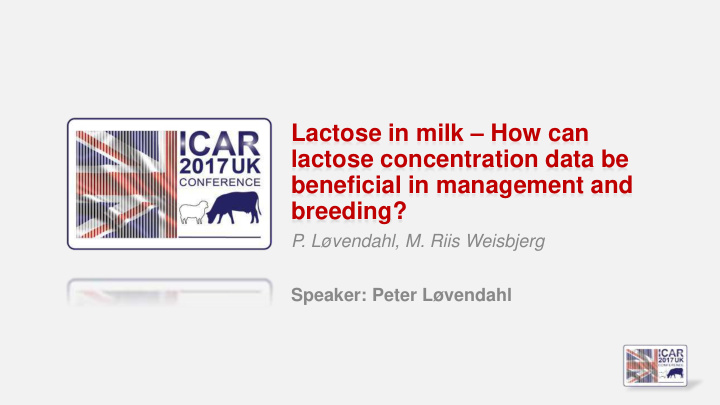



Lactose in milk – How can lactose concentration data be beneficial in management and breeding? P. Løvendahl, M. Riis Weisbjerg Speaker: Peter Løvendahl
Lactose in in mil ilk – How can la lactose concentration data be beneficial in in management and breeding? Peter Løvendahl and Martin Riis Weisbjerg Dept. of Molecular Biology and Genetics, QGG Dept. of Animal Science
Why is lactose percentage interesting? THIS TALK IS NOT ABOUT LACTOSE INTOLERANCE • Lactose is at 4.5 to 5.0 % of the milk weight • Lactose is making up 18 to 25% of milk energy content • Lactose is part of the ECM calculation • Lactose used to be a worthless by-product, fed to pigs and calves • More recently: Lactose has an increasing economic market value
Lactose has an in increasing economic market valu lue • Market price, USA
Some dairy ry processors pay for lactose – others don’t … • 1000 kg milk, 4.2% fat, 3.4% Protein, 4.5% Lactose • Campina: pay for milk fat, protein and lactose – no cost for volume (transport) 1000 kg, 3.0 € *42 kg fat + 6 € * 34 Kg protein + 0.6 € * 45 Kg lactose = 357 € • Arla: pay for kilo fat and protein – cost for volume (transport) 1000 kg milk, 4.2% fat, 3.4% Protein, 4.50% Lactose Price = 3.72 € * 42 Kg Fat + 5.21 € * 34 Kg Protein – 0.0133 € * 1000Kg = 320 € + expected bonus ~37 € = 357 € / t www …. Arla … Campina
Some analyze test day samples – others not • Do: Austria, Finland, France, The Netherlands , … • Not: Canada, Denmark, Sweden …. • Bulk tank samples usually follow same procedure
Variation in in lactose % % Normal variation and biological effects Holstein - Parity 1 Mean P_05% P_95% Lactose % 4.97 4.49 5.44 Protein % 3.54 2.97 4.19 Fat % 4.20 3.17 5.49 Milk Kg 28.3 17.3 39.0 • How can lactose be changed? • Feeding strategies ? • Genetic strategies ? • Correlations to other traits ? Data from Danish Cattle Research Centre
• Breed • Age • Lactation stage Data from Danish Cattle Research Center
ECM or FPCM? Role of Lactose% ECM = kg_milk / 3140 * ( 383*fat_% + 242*protein_% + 157*lactose_% + 20.7 ) FPCM = kg_milk / 3140 * ( 383*fat_% + 242*protein_% + 783.2) Formulas from Sjaunja et al. 1990.
• Parity When is FPCM deviating fr from ECM? • Lactation stage • Breed Holstein Jersey Data from Danish Cattle Research Center
Feeding effects – Milking fr frequency effects More concentrates > higher lactose; no effect of milking frequency Andersen et al 2003, Livestock 81:119-128
Genetic variation in in la lactose % % - hig ighly heritable! ! Løvendahl, Su, and Friggens 2003
• High heritabilty for % lactose • Lower h 2 for Kg Lactose / d
Sid ide effects? • Correlations to mastitis? – • Low lactose% correlates to somatic cell count – but not strongly • Other correlations – not described in large data sets!
Summing up… • Technical advances and changes in demand gives more market value to lactose – but payments may not reflect value! • Lactose % follow lactation curve for liquid milk • Lactose % varies less than protein % • Feeding more concentrates and more protein gives higher lactose% • Genetic selection for higher lactose % is possible • Side effects of higher lactose % are favourable or neutral • Test-day data only available in few countries • Adding lactose to ”standard panel” is inexpensive and simple – • Go and do it!
Conclusions and and what to do.. • Lactose has economic value for dairy processors • Lactose % is an important part of the energy output from cows • Lactose % may be changed through feeding or through genetic selection - if we want to do so! • Lactose % measurements can be easily implemented in test day recording schemes and genetic evaluations when data is there!
Questions …
Recommend
More recommend